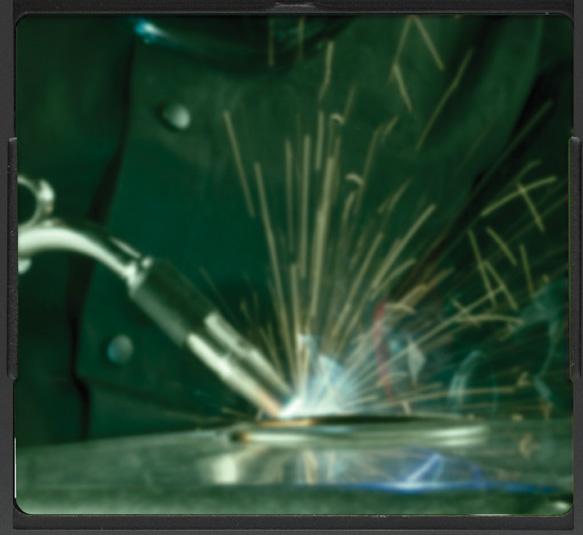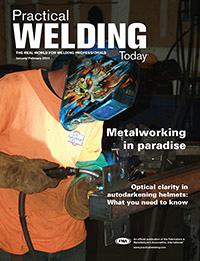Senior Product Manager—Welding Group
- FMA
- The Fabricator
- FABTECH
- Canadian Metalworking
Categories
- Additive Manufacturing
- Aluminum Welding
- Arc Welding
- Assembly and Joining
- Automation and Robotics
- Bending and Forming
- Consumables
- Cutting and Weld Prep
- Electric Vehicles
- En Español
- Finishing
- Hydroforming
- Laser Cutting
- Laser Welding
- Machining
- Manufacturing Software
- Materials Handling
- Metals/Materials
- Oxyfuel Cutting
- Plasma Cutting
- Power Tools
- Punching and Other Holemaking
- Roll Forming
- Safety
- Sawing
- Shearing
- Shop Management
- Testing and Measuring
- Tube and Pipe Fabrication
- Tube and Pipe Production
- Waterjet Cutting
Industry Directory
Webcasts
Podcasts
FAB 40
Advertise
Subscribe
Account Login
Search
1+1+1+1 = Clarity
Everything you need to know about autodarkening helmet optical clarity
- By Jamy Bulan
- January 21, 2015
- Article
- Safety
Everyone knows welding helmets are designed to protect both your face and eyes from sparks, arc flash, and particulate. That’s why you wear them. But choosing the right helmet reaches beyond basic occupational safety considerations. Helmets can affect your comfort on the job and your overall productivity, not to mention the quality of your work. And, it all comes down to seeing clearly.
A concept known as optical clarity plays a large role in how well you can see when wearing an autodarkening helmet. A helmet that’s too dark, or one that has too many variations in the quality of sight through the filter, can hinder your vision in the welding booth, causing discomfort, sight problems, and even irregular welds when you pick up a torch. When it comes to your eyesight in a welding booth or out in the field, it’s important to use top-level technology.
Helmet Standards
While the U.S. has yet to adopt any formal requirements for welding helmet design, manufacturers are starting to look to the third-party European standards that govern eye and face protection for welders for guidance. Prefixed by EN (European Norm), these standards include EN 166 (visors), EN 169 (shade/transmittance of filter in scale numbers), EN 175 (welding shields), and EN 379 (autodarkening welding cartridges). Every helmet sold in Europe is rated under this system before reaching retail channels.
The latter two standards incorporate important ratings for optical clarity. These ratings are determined through tests that measure light transmission across the welding cartridge, as well as scattered light from the cartridge’s layers.
Autodarkening cartridges undergo evaluation in four important categories, all referring to optical clarity. Each category is graded on a scale of 1 to 3, with a score of 1 being the best (perfect) and a score of 3 being the worst. Increasingly, helmet manufacturers are developing products that pass all tests with the highest scores, yielding a 1/1/1/1 rating, the best available.
- Optical class (accuracy of vision). Think about how distorted things appear underwater when you look down into the water (see Figure 1). This class qualifies how distorted the image is when you are looking at it through a welding helmet lens. Distortion is minimal if you are looking through a 1-rated lens.
- Diffusion of light class. This rating is related to impurities in the glass during the manufacturing process. Think about how things look if you have scratches on a pair of glasses; the lens isn’t clear (see Figure 2). Helmets with a 1 rating in this class have a lens with exceptionally clear materials versus one with impurities. Impurities are common with inexpensive helmets. A 1-rated lens in this category has uniform lens material when you look through it, giving you a clear view.
- Variations in luminous transmittance class (light or dark areas within the lens). This rating focuses on the lens’s adjustable shade function. Helmets typically offer shade that adjusts between a level of 4 and 13, with a level 9 as the minimum allowable shade for welding. To rate the variations in luminous transmittance across a shade, testers examine the consistency of shade at different points of the lens. For example, if you have the shade set to a 10, there should be very little variability across the lens from left to right, up or down, or in the corners. Inconsistencies in shade will affect the optical clarity, leaving areas that are too bright or dark (see Figure 3). A rating of 1 means that the lens delivers even shade across its surface.
- Angle dependence on luminous transmittance class. This category tests for a clear view without stretching, dark areas, blurriness, or problems viewing objects at an angle (see Figure 4). Similar to the variations in luminous transmittance class, this rating examines whether or not the lens delivers a consistent level of shade at an angle, such as looking downward or upward through it, as it does when you look straight through it. On a lower-rated lens, the shade often darkens when you look through it at an angle. With a 1-rated lens, the shade remains consistent no matter the viewing angle.
Why Is Optical Clarity Important While Welding?
Autodarkening welding helmets carrying the EN 379 1/1/1/1 rating deliver even shade levels across the full height and width of the viewing area. This means the helmet offers a larger shaded area that covers the entire cartridge, yet it also reduces bright, visible light. Most manufacturers haven’t achieved the 1/1/1/1 score yet, particularly in the U.S. This rating isn’t a requirement here, but it now does provide a known benchmark for quantifying lens clarity.
The benefit is it eliminates the traditional trial-and-error game of trying on helmets and determining which one has the best viewing lens. Welders looking to upgrade a helmet now know that one with a 1/1/1/1 optical clarity rating will deliver a perfect view and the best-quality lens.
Welding is not an easy process, especially when you think about welders who wear a helmet for the better part of an eight- to 10-hour shift, sometimes working on exotic, thin, or expensive materials. For the welder to be able to perceive subtle variations in the ever-changing arc and weld puddle, the clearer the view, the better. When you weld, you constantly adjust your angle and travel speeds based on changing conditions at the arc. As a result, the capability to clearly view what is going on in the weld puddle will help you deliver more accurate end results, with higher-quality welds.
Experienced welders who have used a 1/1/1/1-rated helmet can immediately tell the difference in optical clarity. They report that they see better, the workpiece is clearer, and the experience is more comfortable than when they are wearing a helmet rated, for example, at 1/2/1/2. They see the arc without distortion in the higher-rated lens and notice clarity issues in the one that is rated lower. While we are talking about subtle parameters, professional welders can notice the difference between a 1 and a 2, and a huge difference between a 1 and a 3.
What’s more, optical clarity plays a role in welder productivity. If you’re looking through a distorted lens with impurities and inconsistent shade, your eyes will strain to see what you are doing, causing you to work harder. Viewing your welds through a clearer, better-quality lens will allow your eyes to work longer and also put less overall strain on your body.
Other Considerations
Selecting a helmet involves more than just pulling one off of a shelf, putting it on, and getting to work. A number of considerations come into play during the selection process—personal safety, wearer comfort, and optical clarity.
The latter has moved from something hard to determine without guesswork to something that has true quantifiable benchmarks with the advent of EN 379 1/1/1/1. As global manufacturers increasingly communicate the use of this standard to manufacturers and welders in the U.S., demand for better optical clarity in U.S. helmets grows.
Other design factors come into play when selecting the best welding helmet for the job. Cartridge switching speed—when an autodarkening cartridge switches from bright to dark when you strike an arc—is another benchmark for overall quality. The human eye can sense variations in light in 1⁄2,000 of a second, if something flashes that fast. The highest-quality autodarkening cartridges can determine flash at rates as quickly as 1⁄25,000 of a second, 10 times faster than what the eye perceives. That means the switch from light to dark is so fast that your eyes have virtually no chance of being damaged by the arc.
Another aspect to keep in mind when looking for a high-quality helmet is the size of the viewing screen that contains the lens, as this feature affects not only what you see, but also how frequently you need to move your head and neck as you weld. The helmet viewing area is extremely important to welder comfort.
As an exaggerated example, picture looking at the world around you through a paper towel tube. It’s a very small window of vision, and you really need to move around a lot to see what’s around you through it. In a similar manner, the smaller the viewing area on a welding helmet, the more you are going to have to move your head and neck as you weld to see your workpiece accurately and comfortably. A large viewing area helps alleviate this stress and can, as a result, increase your productivity because you are more comfortable.
When evaluating helmets, be sure also to consider headgear style and adjustability, the overall weight, whether or not the helmet can lower with a simple head nod, hands-free operation, and even the comfort of the built-in sweatband. All can affect your comfort and productivity.
Think of a high-quality autodarkening cartridge in the same way as you think of your TV. Do you still want to watch sports and movies on an old, grainy analog screen, or do you want to upgrade to a high-definition LCD screen? Shouldn’t you want the same for a welding helmet that you wear all day long while you aim to produce quality welds? A helmet with 1/1/1/1 optical clarity helps you achieve this.
About the Author
Jamy Bulan
22801 St. Clair Ave.
Cleveland, OH 44117
216-383-4109
About the Publication
Related Companies
subscribe now

The Welder, formerly known as Practical Welding Today, is a showcase of the real people who make the products we use and work with every day. This magazine has served the welding community in North America well for more than 20 years.
start your free subscription- Stay connected from anywhere

Easily access valuable industry resources now with full access to the digital edition of The Fabricator.

Easily access valuable industry resources now with full access to the digital edition of The Welder.

Easily access valuable industry resources now with full access to the digital edition of The Tube and Pipe Journal.
- Podcasting
- Podcast:
- The Fabricator Podcast
- Published:
- 04/16/2024
- Running Time:
- 63:29
In this episode of The Fabricator Podcast, Caleb Chamberlain, co-founder and CEO of OSH Cut, discusses his company’s...
- Industry Events
16th Annual Safety Conference
- April 30 - May 1, 2024
- Elgin,
Pipe and Tube Conference
- May 21 - 22, 2024
- Omaha, NE
World-Class Roll Forming Workshop
- June 5 - 6, 2024
- Louisville, KY
Advanced Laser Application Workshop
- June 25 - 27, 2024
- Novi, MI


































